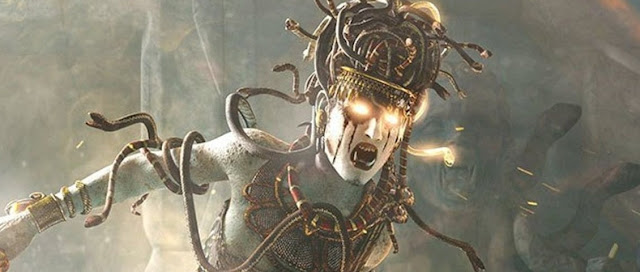"Mystery Unsolved-6'
"The Curse Of Medusa"
 |
| Medusa |
Medusa is an instantly recognizable figure from ancient Greek art. Her face, whether fierce and grotesque or feminine and composed, appears in virtually all media in varying contexts. The most common interpretation of Medusa suggests she is an apotropaic symbol used to protect from and ward off the negative, much like the modern evil eye. She represents a dangerous threat meant to deter other dangerous threats, an image of evil to repel evil. A close look at her role in Greek mythology and art reveals a nuanced and complex character with multiple iterations and implications.Medusa is best known for having hair made of snakes and for her ability to turn anyone she looked at to stone, literally to petrify.
 |
| Medusa |
Medusa as originally being a beautiful maiden. Her beauty caught the eye of Poseidon, who desired her and proceeded to ravage her in Athena’s shrine. When Athena discovered the sea god had ravaged Medusa in her shrine she sought vengeance by transforming Medusa’s hair into snakes, so that anyone who gazed at her directly would be turned into stone.
 |
| Medusa |
Polydectes fell in love with Perseus' mother and wished to marry her but Perseus was protective of his mother since he believed Polydectes to be dishonorable. Polydectes contrived to trick Perseus; he held a large banquet under the pretense of collecting contributions for the marriage of Hippodamia, who tamed horses. He requested that his guests bring horses for their gifts but Perseus did not have one. When Perseus confessed that he had no gift, he offered any gift the king would name. Polydectes seized his opportunity to disgrace and even get rid of Perseus and asked for the head of the only mortal Gorgon: Medusa.
 |
| The Legend of Medusa |
As Perseus was the son of Zeus, he was aided by the gods. Perseus received the Cap of Invisibility from Hades, a pair of winged sandals from Hermes, a reflective bronze shield from Athena, and a sword from Hephaestus. With these divine gifts, Perseus sought out Medusa and decapitated her with the bronze shield while she was asleep avoid her petrifying gaze while he beheaded her with a harpe, an adamantine sword. Such a violent act resulted in the birth of Medusa’s children, the winged horse Pegasos and the giant Chrysaor, who sprung from her neck.When the blood dripped from Medusa’s head onto the plains of Libya, each drop of blood transformed into venomous serpents.
 |
| Medusa |
 |
| Medusa |
Before his return to his home of Seriphos, Perseus met the titan Altas, who he turned to stone with Medusa's head after some quarrelsome words, thus creating the Atlas Mountains of North Africa. Also during the journey home, Medusa's head spilled some blood on the earth which formed into Libyan vipers that killed the Argonaut Mospos.
Perseus returned home to his mother, safe from King Polydectes' advances, but Perseus was infuriated with Polydectes' trickery. Perseus avenged himself by turning Polydectes and his court to stone with Medusa's head. He, then, gave the kingdom to Dictys. After Perseus was finished with the Gorgon's head, he gave it to Athena, who adorned her shield and breastplate with it.
 |
| Medusa |
According to another account Hercules is said to have obtained a lock of Medusa’s hair (which possessed the same powers as the head) from Athena and given it to Sterope, the daughter of Cepheus, as a protection for the town of Tegea against attack; when exposed to view, the lock was supposed to bring on a storm, which put the enemy to flight.
 |
| Statue of Medusa |
Several thousands years passed,but the myth of Medusa is sill alive.Some says her head is still in this world somewhere kept hidden & it still holds the power of petrification.
Comments
Post a Comment